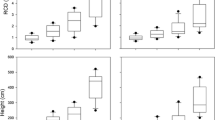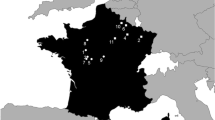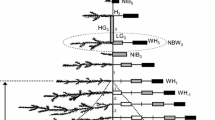Abstract
We analyzed temporal patterns in diameter growth of saplings following selection harvesting in an uneven-aged mixed stand dominated by Abies sachalinensis, Acer mono, Quercus crispula, and Betula ermanii in Hokkaido, northern Japan. We examined interspecific differences in growth responses to local growing conditions including harvesting intensity, crowding, stem size, and past duration of the small growth period. Consistent with expectations based on shade tolerance of the species, the age at which the individual reached a diameter at breast height (DBH) of 12.5 cm was highest for A. sachalinensis and lowest for B. ermanii. The interspecific growth differences between saplings that had or had not experienced local harvesting increased gradually for A. sachalinensis and B. ermanii, but peaked at around 4–6 years after harvesting for Q. crispula. Generalized linear mixed model analysis clearly suggested that individual growth conditions required to enhance diameter growth of saplings differed considerably among species. For Q. crispula and B. ermanii, local harvesting intensity was most strongly and positively associated with diameter growth rate, whereas for A. sachalinensis and A. mono, stem size had the strongest negative effect. Abies sachalinensis saplings responded more to surrounding harvesting when they were relatively small, whereas A. mono showed a weak opposite response. The duration of the small growth period before harvesting had negative effect for A. sachalinensis, but not for the other species. Our study indicated that the influence of selection harvesting on growth of shade-tolerant species depends upon pre- and post-harvest growing conditions.




Similar content being viewed by others
References
Abe M, Izaki J, Miguchi H, Masaki T, Makita A, Nakashizuka T (2002) The effects of sasa and canopy gap formation on tree regeneration in an old beech forest. J Veg Sci 13:565–574
Abrams MD, Copenheaver CA, Terazawa K, Umeki K, Takiya M, Akashi N (1999) A 370-year dendroecological history of an old-growth Abies–Acer–Quercus forest in Hokkaido, northern Japan. Can J Forest Res 29:1891–1899
Attiwill PM (1994) The disturbance of forest ecosystems—the ecological basis for conservative management. Forest Ecol Manage 63:247–300
Bebber DP, Thomas SC, Cole WG, Balsillie D (2004) Diameter increment in mature eastern white pine Pinus strobus L. following partial harvest of old-growth stands in Ontario, Canada. Trees Struct Funct 18:29–34
Canham CD (1985) Suppression and release during canopy recruitment in Acer saccharum. Bull Torrey Bot Club 112:134–145
Canham CD (1990) Suppression and release during canopy recruitment in Fagus grandifolia. Bull Torrey Bot Club 117:1–7
Cho DS, Boerner REJ (1995) Dendrochronological analysis of the canopy history of two Ohio old-growth forests. Vegetatio 120:173–183
DiGregorio LM, Krasny ME, Fahey TJ (1999) Radial growth trends of sugar maple (Acer saccharum) in an Allegheny northern hardwood forest affected by beech bark disease. J Torrey Bot Soc 126:245–254
Franklin JF (1993) Preserving biodiversity—species, ecosystems, or landscapes. Ecol Appl 3:202–205
Fukuzawa K, Shibata H, Takagi K, Nomura M, Kurima N, Fukazawa T, Satoh F, Sasa K (2006) Effects of clear-cutting on nitrogen leaching and fine root dynamics in a cool-temperate forested watershed in northern Japan. Forest Ecol Manage 225:257–261
Hiura T, Fujiwara K, Hojyo H, Okada J, Udo H, Okuyama S, Morita H, Fukuda H, Fujito E, Fukui T, Takahata M, Udo K, Sugiyama H, Takeda T (1995) Stand structure and long-term dynamics of primeval forest in Nakagawa experimental forest, Hokkaido University. Res Bull Coll Exp Hokkaido Univ 52:85–94 (in Japanese with an English summary)
Hix DM, Lorimer CG (1990) Growth-competition relationships in young hardwood stands on 2 contrasting sites in southwestern wisconsin. For Sci 36:1032–1049
Ishizuka M, Kanazawa Y (1989) Growth process of Abies sachalinensis under Picea jezoensis, Tilia japonica, and Acer mono in mixed coniferous–broadleaved forests of Hokkaido. J Jap For Soc 71:281–287 (in Japanese with an English summary)
Johnson JB, Omland KS (2004) Model selection in ecology and evolution. Trends Ecol Evol 19:101–108
Jones TA, Thomas SC (2004) The time course of diameter increment responses to selection harvests in Acer saccharum. Can J For Res 34:1525–1533
Kneeshaw D, Williams H, Nikinmaa E, Messier C (2002) Patterns of above- and below-ground responses of understory conifer release 6 years after partial cutting. Can J For Res 32:255–265
Koike T (1988) Leaf structure and photosynthetic performance as related to the forest succession of deciduous broad-leaved trees. Plant Species Biol 3:77–87
Kubota Y (2000) Spatial dynamics of regeneration in a conifer/broad-leaved forest in northern Japan. J Veg Sci 11:633–640
Kubota Y, Konno Y, Hiura T (1994) Stand structure and growth patterns of understorey trees in a coniferous forest, Taisetsuzan National Park, northern Japan. Ecol Res 9:333–341
Latham P, Tappeiner J (2002) Response of old-growth conifers to reduction in stand density in western Oregon forests. Tree Physiol 22:137–146
Lovelock CE, Jebb M, Osmond CB (1994) Photoinhibition and recovery in tropical plant species—response to disturbance. Oecologia 97:297–307
Lundqvist L (1993) Changes in the stand structure on permanent Picea–Abies plots managed with single-tree selection. Scand J For Res 8:510–517
Masaki T (2002) Structure and dynamics. In: Nakashizuka T, Matsumoto Y (eds) Diversity and interaction in a temperate forest community: Ogawa Forest SDreserve of Japan. Springer, Tokyo, pp 53–65
Matsuda K, Shibuya M, Koike T (2002) Maintenance and rehabilitation of the mixed conifer–broadleaf forests in Hokkaido, northern Japan. Eurasian J For Res 5:119–130
Messier C, Doucet R, Ruel JC, Claveau Y, Kelly C, Lechowicz MJ (1999) Functional ecology of advanced regeneration in relation to light in boreal forests. Can J For Res 29:812–823
Muth CC, Bazzaz FA (2003) Tree canopy displacement and neighborhood interactions. Can J For Res 33:1323–1330
Nagaike T, Kubota Y, Watanabe N (1999) The effects of selective logging on stand structure and the regeneration of subboreal forests in Hokkaido, northern Japan. J For Res 4:41–45
Noguchi M, Yoshida T (2005) Factors influencing the distribution of two co-occurring dwarf bamboo species (Sasa kurilensis and S. senanensis) in a conifer–broad-leaved mixed stand in northern Hokkaido. Ecol Res 20:25–30
Noguchi M, Yoshida T (2007) Regeneration responses influenced by single-tree selection harvesting in a mixed-species tree community in northern Japan. Can J For Res 37:1554–1562
Noguchi M, Yoshida T (2009) Individual-scale responses of five dominant tree species to single-tree selection harvesting in a mixed forest in Hokkaido, northern Japan. J For Res (in press)
Ohgane E, Nigi T, Hishinuma Y, Koshika K, Fukui T (1988) Managerial progress and result of an experimental forest practiced by the control method. Res Bull Coll Exp Hokkaido Univ 45:61–113 (in Japanese with an English summary)
Takahashi K, Mitsuishi D, Uemura S, Suzuki JI, Hara T (2003a) Stand structure and dynamics during a 16-year period in a sub-boreal conifer–hardwood mixed forest, northern Japan. For Ecol Manage 174:39–50
Takahashi K, Uemura S, Suzuki JI, Hara T (2003b) Effects of understory dwarf bamboos on soil water and the growth of overstory trees in a dense secondary Betula ermanii forest, northern Japan. Ecol Res 18:767–774
Tatewaki M (1958) Forest ecology of the islands of the North Pacific Ocean. J Fac Agric Hokkaido Univ 50:371–486
R Development Core Team (2008). R: a language and environment for statistical computing. R Foundation for Statistical Computing, Vienna. ISBN 3-900051-07-0, URL http://www.R-project.org
Umeki K (1995) A comparison of crown asymmetry between Picea–Abies and Betula maximowicziana. Can J For Res 25:1876–1880
Umeki K (2001) Growth characteristics of six tree species on Hokkaido island, northern Japan. Ecol Res 16:435–450
Umeki K, Kikuzawa K (1999) Long-term growth dynamics of natural forests in Hokkaido, northern Japan. J Veg Sci 10:815–824
Wright EF, Canham CD, Coates KD (2000) Effects of suppression and release on sapling growth for 11 tree species of northern, interior British Columbia. Can J For Res 30:1571–1580
Yajima T (1982) Study on the growth of main tree species in the mixed forest of needle-leaved and broad-leaved trees. Res Bull Coll Exp Hokkaido Univ 39:1–54 (in Japanese with an English summary)
Yoshida T, Kamitani T (1998) Effects of crown release on basal area growth rates of some broad-leaved tree species with different shade-tolerance. J For Res 3:181–184
Yoshida T, Noguchi M, Akibayashi Y, Noda M, Kadomatsu M, Sasa K (2006) Twenty years of community dynamics in a mixed conifer–broad-leaved forest under a selection system in northern Japan. Can J For Res 36:1363–1375
Youngblood AP (1991) Radial growth after a shelterwood seed cut in a mature stand of white spruce in interior Alaska. Can J For Res 21:410–413
Acknowledgments
We would like to thank anonymous reviewers for their helpful comments and suggestions. We also thank the staff of the Nakagawa Experimental Forest and the members of the Laboratory of Forest Management, Hokkaido University, for their combined efforts in maintaining the long-term monitoring. We thank Keiichi Aoyama and Akane Harada for their assistance with the fieldwork. We also extend our thanks to the members of the Laboratory of Forest Ecosystem Management, Hokkaido University. This research was partially funded by Grants in Aid for Scientific Research (nos. 18201008 and 19208013) from the Ministry of Education, Science, and Culture, Japan.
Author information
Authors and Affiliations
Corresponding author
About this article
Cite this article
Miya, H., Yoshida, T., Noguchi, M. et al. Individual growing conditions that affect diameter increment of tree saplings after selection harvesting in a mixed forest in northern Japan. J For Res 14, 302–310 (2009). https://doi.org/10.1007/s10310-009-0136-6
Received:
Accepted:
Published:
Issue Date:
DOI: https://doi.org/10.1007/s10310-009-0136-6




